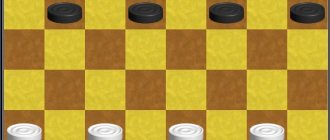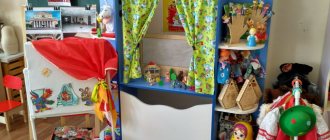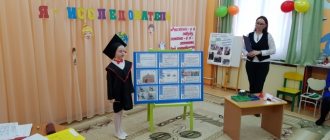Slide captions:
Modern gaming technologies in the development of preschool children Prepared by: Senchenko Irina Viktorovna Senior teacher of the MDOU “Combined kindergarten No. 19p. Razumnoye, Belgorod district, Belgorod region"
“Play generates joy, freedom, contentment, peace in oneself and around oneself, peace with the world” Friedrich Froebel “Without play there is and cannot be full mental development. A game is a huge bright window through which a life-giving stream of ideas and concepts of the surrounding world flows into the child’s spiritual world. The game is the spark that ignites the flame of inquisitiveness and curiosity" V.A. Sukhomlinsky
Currently, teaching staff of preschool educational institutions are intensively introducing innovative technologies into their work. Modern educational technologies, health-saving technologies; technology of project activities; research technology; information and communication technologies; person-oriented technologies; portfolio technology for preschoolers and teachers; gaming technology; TRIZ technology, etc.
Technology is a set of techniques used in any business, skill, or art (explanatory dictionary). Pedagogical technology is a set of psychological and pedagogical attitudes that determine a special set and arrangement of forms, methods, methods, teaching techniques, educational means; it is an organizational and methodological toolkit for the pedagogical process. (B.T. Likhachev) A fundamentally important aspect in pedagogical technology is the child’s position in the educational process, the attitude of adults towards the child. When communicating with children, an adult adheres to the position: “Not next to him, not above him, but together!” Its goal is to promote the development of the child as an individual.
In the light of the Federal State Educational Standard, the child’s personality is in the foreground and the entire preschool childhood should be devoted to play. Play is the leading activity of a child. In the game he develops as a personality, he develops those aspects of his psyche on which the success of his social practice will subsequently depend. The game is a testing ground for children’s social tests, that is, those tests that children choose for self-test and during which they master ways to solve problems of interpersonal relationships that arise during the game. The game creates the basis for a new leading activity - educational. Therefore, the most important task of pedagogical practice is to optimize and organize a special space in a preschool educational institution to activate, expand and enrich the play activity of a preschooler. Play is not only fun and joy for a child, but also reinforces skills that he has recently mastered. Children feel independent in the game, communicate with peers at will, realize and deepen their knowledge and skills. While playing, children learn about the world around them, study colors, shapes, material properties and space, get acquainted with plants and animals, and adapt to the diversity of human relationships. Thus, gaming technology plays a major role in the development of a child and is the foundation of all preschool education.
Gaming technology It is built as a holistic education, covering a certain part of the educational process and united by common content, plot, and character. It includes sequentially: games and exercises that develop the ability to identify the main, characteristic features of objects, compare and contrast them; groups of games to generalize objects according to certain characteristics; groups of games, during which preschoolers develop the ability to distinguish real from unreal phenomena; groups of games that develop the ability to control oneself, speed of reaction to a word, phonemic hearing, ingenuity, etc. Compiling gaming technologies from individual games and elements is the concern of every educator.
The goal of gaming technology is not to change the child and not to remake him, not to teach him any special behavioral skills, but to give him the opportunity to “live” situations that excite him in the game with the full attention and empathy of an adult. Objectives of gaming technology 1. To achieve a high level of motivation, a conscious need in mastering knowledge and skills through the child’s own activity 2. Select means that activate children’s activities and increase their effectiveness
Target orientations of gaming technologies: • Didactic: broadening horizons, cognitive activity, formation of certain skills and abilities, development of work skills. • Educating: nurturing independence, will, cooperation, collectivism, communication. • Developmental: development of attention, memory, speech, thinking, ability to compare, contrast, find analogues, imagination, fantasy, creative abilities, development of motivation for learning activities. • Socializing: familiarization with the norms and values of society, adaptation to environmental conditions, self-regulation.
Functions of the game: • Entertaining (this is the main function of the game - to entertain, provide satisfaction, inspire, arouse interest); • Communicative: everything related to the game is located in a single game space and serves as a means of transmitting social experience • Game therapy: overcoming various difficulties that arise in other types of life activities; • Diagnostic: identifying deviations from normative behavior, self-knowledge during the game; • Correction function: making positive changes to the structure of personal indicators; • Socialization function: inclusion in the system of social relations, assimilation of the norms of human society
Four main features inherent in the game: • free developmental activity, undertaken only at the request of the child, for the sake of pleasure from the process of activity itself, and not just from the result (procedural pleasure); • creative, largely improvisational, very active nature of this activity (“field of creativity”); • emotional elation of activity, rivalry, competitiveness, competition, etc. (sensual nature of the game, “emotional tension”); • the presence of direct or indirect rules that reflect the content of the game, the logical and temporal sequence of its development.
Using gaming technologies in the educational process, an adult must have: 1). Goodwill 2). Be able to provide emotional support 3). Create a joyful environment 4). Encouraging any invention and fantasy of the child. Only in this case will the game be useful for the development of the child and creating a positive atmosphere of cooperation with adults. An important feature of gaming technologies that educators use in their work is that gaming moments penetrate all types of children’s activities: work and play, organized educational activities and games, everyday household activities associated with the implementation of the regime and games.
Motto: Create situations where their participants want to trust each other and their experience, resulting in the effect of voluntary learning, training and teaching. Goal: Development of social qualities of the individual, formation of a communicative culture of children through the use of games as the main form of organizing the lives of preschool children. . Socio - gaming technologies
Key ideas Organization of children's own activities, in which the child does, listens, looks and speaks. Get away from the children. Spartan education (moving desks, working on the carpet, in the waiting room, etc.) Together we are strong. It is not possible for us to predict how our word will respond.
Forms of organization: Collective activities, work in small groups in classes, training on the ability to negotiate. Fairy tale therapy Self-presentation Trainings Techniques socially aimed at creating situations of success and comfort. Methods for creating problem situations with elements of self-esteem. Games with rules, competition games, dramatization games, role-playing games and director's games.
Classification of games with a socio-game orientation. (E.E. Shuleshko, A.P. Ershova, V.M. Bukatov) 1. Games for a working mood. The main task is to awaken children’s interest in each other, to make the participants dependent on each other 2. Warm-up games. The principle of universal accessibility, an element of competition, funny, frivolous winning. 3.Games of creative self-affirmation. When performing them, the artistic and performing result of the action is taken into account. 4. Games of socio-game involvement in the matter. Can be used in the process of mastering or consolidating educational material: if children learn to distinguish, remember, systematize, performing game tasks 5. Free games. (in the wild) Games that require space and freedom of movement, i.e. they cannot always be performed in the room.
Sand Art - using the sand painting method in a preschool educational institution “The best toy for children is a pile of sand” K.D. Ushinsky
Sand animation (drawing with sand) has a number of positive aspects:
Sand painting techniques
An educational quest is a completely new form of educational and entertainment programs, with the help of which children are completely immersed in what is happening, receive a charge of positive emotions and are actively involved in activities, because what could be more exciting than a good game?
IDEA OF THE GAME The team (player), moving around the points, performs various tasks, but the highlight of this organization of gaming activity is that, having completed one task, the children receive a hint to complete the next one.
Quests help solve educational GOALS: implement project and game activities; introduce new information; consolidate existing knowledge; practice children’s skills;
TASKS FOR QUESTS: Search for “treasures”. Incident investigation (good for experimental activities). Help the heroes. Journey. Adventures based on works of fiction (similar to board games).
THE ROLE OF THE TEACHER in the quest game is organizational, i.e. The teacher determines the educational goals of the quest, draws up the storyline of the game, evaluates the process of children’s activities and the final result, and organizes search and research educational activities.
The ADVANTAGE of quest technology is that it does not require any special training for teachers, the purchase of additional equipment or investment of funds. The main thing is the great desire of the teaching staff to lay the foundations of a full-fledged socially successful personality during preschool childhood.
LEGO pedagogy is one of the well-known and widespread pedagogical systems today, using three-dimensional models of the real world and a subject-game environment for the learning and development of a child. The universal construction set stimulates mental activity and develops hand motor skills.
Goal: Creation of a modern educational environment for the comprehensive development of a child’s personality in various activities through the use of LEGO construction technology.
Possibility of using this approach. LEGO construction can be considered as an effective way to optimize the educational process of any preschool educational institution.
References: Sinyakova E.A. “Game technologies in preschool educational institutions” Valitova I.E. “Psychology of development of a preschool child” Nekoz I.L. “Developing a child’s personality in play” Sakovich N.A. sand play technology. Games on the bridge. – St. Petersburg, 2006. Fedorova M.A. “Organization of life, education and training of children in small groups”, (Krasnoyarsk, - 2007)
Presentation “Game technologies in kindergarten”
Venera Krivova
Presentation “Game technologies in kindergarten”
3 slide
“Without play there is not and cannot be full-fledged mental development. A game is a huge bright window through which a life-giving stream of ideas and concepts of the surrounding world flows into the child’s spiritual world. The game is a spark that ignites the fire of inquisitiveness and
curiosity"
V. A. Sukhomlinsky
4slide
In the light of the Federal State Educational Standard, the child’s personality is in the foreground and the entire preschool childhood should be devoted to play. Play is not only fun and joy for a child, but also reinforces skills that he has recently mastered. Children feel independent in the game, communicate with peers at will, realize and deepen their knowledge. While playing, children learn about the world around them, study colors, shapes, material properties and space, get acquainted with plants and animals, and adapt to the diversity of human relationships.
5slide
Gaming technology is built as a holistic education, covering a certain part of the educational process and united by common content, plot, and character. It includes sequential games and exercises that develop the ability to identify the main, characteristic features of objects, compare and contrast them; groups of games to generalize objects according to certain characteristics; groups of games that develop self-control. At the same time, the game plot develops in parallel with the main content of training, helps to intensify the learning process; master a number of educational elements.
6slide
The main goal of gaming technology is
creation of a full-fledged motivational basis for the formation of skills and abilities of activity, depending on the operating conditions of the preschool institution and the level of development of children.
Her tasks:
Achieve a high level of motivation, a conscious need to acquire knowledge and skills through the child’s own activity.
Select means that activate children’s activities and increase their effectiveness.
7slide
Gaming technology is built as a holistic education. It includes sequentially:
Games and exercises that develop the ability to identify the main, characteristic features of objects, compare and contrast them.
Groups of games to generalize objects according to certain characteristics.
Groups of games that develop the ability to control oneself, speed of reaction to a word, phonemic awareness, ingenuity, etc.
Groups of games, during which preschoolers develop the ability to distinguish real from unreal phenomena.
8slide
Technological diagram is a description of a technological process divided into logically interconnected functional elements.
Scientific base - reliance on a certain scientific concept of achieving educational goals.
Systematicity - technology must have logic, interconnection of all parts, integrity.
Controllability - the possibility of goal setting, planning the learning process, step-by-step diagnostics, varying means and methods in order to correct results is assumed.
Efficiency - must guarantee the achievement of a certain standard of training, be effective in terms of results and optimal in costs.
Reproducibility - application to other educational settings
9slide
Gaming technologies are closely related to all aspects of the educational work of a kindergarten and the solution of its main tasks.
Gaming technologies give the child the opportunity to “try on”
assume the most important social roles;
be personally involved in the phenomenon being studied (motivation is focused on satisfying cognitive interests and the joy of creativity); live for some time in “real life conditions”
.
10 slide
The value of gaming technology is not that it is entertainment and relaxation, but that with the right guidance it becomes: a way of learning; activities for the realization of creativity; method of therapy; the first step in the socialization of a child in society.
The educational and educational value of the game depends on:
— knowledge of the methodology of gaming activities ;
- professional skills of the teacher in organizing and managing various types of games;
— taking into account age and individual capabilities
15slide
The purpose of gaming technology is
do not change the child and do not remake him, do not teach him any special behavioral skills, but give him the opportunity to “live”
in the game, situations that excite him with the full attention and empathy of an adult
Compiling gaming technologies from individual games and elements is the concern of every educator!
On the topic: methodological developments, presentations and notes
One of the main indicators of the level of development of a child’s mental abilities is the richness of his speech, so it is important for adults to support and ensure the development of mental and speech abilities.
Game technologies for the mathematical development of preschool children.
Modern effective technologies for speech development of preschool children.
NULL;Game technologies are an integral part of pedagogical technologies.
Modern technologies for the mathematical development of preschoolers are aimed at activating the child’s cognitive activity, the child’s mastery of the connections and dependencies of objects and phenomena in the environment.
Modern technologies for the mathematical development of preschoolers are aimed at activating the child’s cognitive activity, the child’s mastery of the connections and dependencies of objects and phenomena in the environment.
This material will help teachers use TRIZ in their practice to develop the speech of younger preschoolers.
Presentation “Socio - gaming technologies in preschool educational institutions.”
The presentation indicates the goals and objectives of socio-gaming technologies. The forms of organization, key ideas, rules and conditions for organizing the game are revealed. The classification of games with a socio-game orientation is described in detail (E. E. Shulezhko, A. P. Ershova, V. M. Bukatov). The presentation provides examples of the differences between traditional and socio-game pedagogy, as well as the differences between gaming technology and games. Methods for activating mental activity are given. As a result, the results of using socio-game technology are presented.
MAGAZINE Preschooler.RF
Topic: “Game technologies in preschool educational institutions”“Play generates joy, freedom, contentment, peace in oneself and around oneself, peace with the world” Friedrich Froebel
The game has the following features: • Everything that relates to the game is located in a single game space, serves as a means of transmitting social experience and encourages the child to active creative activity. • Adults are participants in the game, whose rights are determined by the rules of the game that govern their relationships. Game features:1. Entertaining (to entertain, give pleasure, arouse the child’s interest)2. Communicative3. Diagnostic (identification of relationships from normal behavior, self-knowledge during the game)4. Corrective (introducing positive changes to the structure of personal indicators)5. Socialization (inclusion in the system of social relations, assimilation of the norms of human society)
Characteristics of types of games by the German psychologist K. Gross:
- group according to pedagogical significance: games that are active, mental, sensory, and develop the will.
- group improvement of instincts: family games, hunting games, courtship.
In domestic preschool pedagogy, a classification of children's games has developed, based on the degree of independence and creativity of children in the game.
P. F. Lesgaft divided children's games into two groups:
- Imitative (imitative)
- Mobile (games with rules)
In the works of N. K. Krupskaya, children's games are divided into two groups:
I. Creative games:
- director's,
- role-playing,
- theatrical,
- games with building materials
II. Games with rules:
1. Outdoor games:
- by degree of mobility (low, medium, high mobility)
- by predominant movements (games with jumping, running, etc.)
- by objects (with a ball, ribbons, hoops, flags, cubes, etc.)
2. Didactic games:
- by content (mathematical, natural history, speech, etc.)
- on didactic material (games with objects and toys, board-printed, verbal)
In recent years, the problem of classifying children's games has again become relevant. A new classification of children's games, developed by S. L. Novoselova, is presented in the program “Origins: Basic program for the development of a preschool child . The classification is based on the idea of whose initiative games arise (child or adult). In our practical play activities with students, we use the classification of S. L. Novoselova.
As proven in the studies of N. Ya. Mikhailenko and E. E. Kravtsova, games develop in the following sequence:
- younger age - role-playing game (game-dialogue);
- middle age – play with rules, theatrical play;
- older age – game with rules, director’s (game – fantasy, game-dramatization)
A fairly significant contribution to the formation of motor skills in children is made by outdoor games, which are included in regular moments from a young age.
Each type of game meets its own goals and objectives and determines the organization of the playing space in the group.
Thus, the phenomenon of play should be treated as a unique phenomenon of childhood. Play is not only an imitation of life, it is a very serious activity that allows a child to assert himself and realize himself. By participating in various games, the child chooses characters that are closest to him and correspond to his moral values and social attitudes. The game becomes a factor in the social development of the individual
| Next > |







